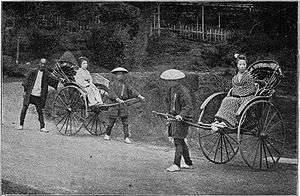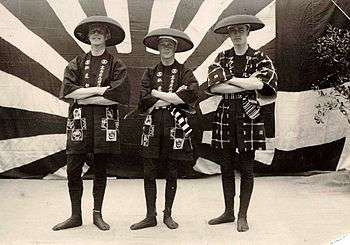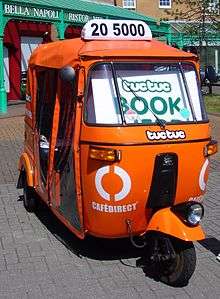Rickshaw


Rickshaw began as a two or three-wheeled passenger cart, called a pulled rickshaw, generally pulled by one man with one passenger. The first known use of the term was in 1887.[1] Over time, cycle rickshaws (also known as pedicabs), auto rickshaws, and electric rickshaws were invented.
Pulled rickshaws created a popular form of transportation, and a source of employment for male laborers, within Asian cities in the 19th century. Their appearance was related to newly acquired knowledge of ball-bearing systems. Their popularity declined as cars, trains and other forms of transportation became widely available.
Auto rickshaws are becoming more popular in some cities in the 21st century as an alternative to taxis because of their low cost.
Etymology
The word rickshaw originates from the Japanese word jinrikisha (人力車, 人 jin = human, 力 riki = power or force, 車 sha = vehicle), which literally means "human-powered vehicle".[2]
History
Origin
Rickshaws were invented in Japan about 1869,[3][4] after the lifting of a ban on wheeled vehicles from the Tokugawa period (1603–1868),[5] and at the beginning of a rapid period of technical advancement in Japan.[4][6]
Inventor
There are several theories about the inventor.
- It was invented in Japan in 1869,[4] by Izumi Yosuke,[7][8] who formed a partnership with Suzuki Tokujiro and Takayama Kosuke to build the vehicles,[9] having been "inspired by the horse carriages that had been introduced to the streets of Tokyo a few years earlier".[10]
- Jonathan Scobie (or Jonathan Goble), an American missionary to Japan, is also said to have invented the rickshaw around 1869 to transport his invalid wife through the streets of Yokohama.[6][11][12]
- An American blacksmith Albert Tolman is said to have invented the rickshaw, or "man drawn lorry", in 1846 in Worcester, Massachusetts, for a South American bound missionary.[13]
- In New Jersey, the Burlington County Historical Society claims an 1867 invention by carriage maker James Birch, and exhibits a Birch rickshaw in its museum.[14]
Japan historian Seidensticker wrote of the theories:
Though the origins of the rickshaw are not entirely clear, they seem to be Japanese, and of Tokyo specifically. The most widely accepted theory offers the name of three inventors, and gives 1869 as the date of invention.[3]
Description
The vehicle had a wooden carriage that rode on "superior Western wheels" and was a dramatic improvement over earlier modes of transportation. Whereas the earlier sedan chairs required two people, the rickshaw generally only required one. More than one person was required for hilly or mountainous areas. It also provided a smoother ride for the passenger. Other forms of vehicles at the time were drawn by animals or were wheelbarrows.[4]
The Powerhouse Museum has had a rickshaw in its collection for 120 years. It was made about 1880 and is described as:
A rickshaw, or Jinrikisha, is a light, two-wheeled cart consisting of a doorless, chairlike body, mounted on springs with a collapsible hood and two shafts. Finished in black lacquer-ware over timber, it was drawn by a single rickshaw runner.[15]
Late 19th century

It became an inexpensive, popular mode of transportation across Asia.[4] Peasants who migrated to large Asian cities often worked first as a rickshaw runner.[16][17] It was "the deadliest occupation in the East, [and] the most degrading for human beings to pursue."[17][nb 1]
Japan

Starting in 1870, the Tokyo government issued a permit to build and sell 人力車 (jinrikisha : rickshaws in Japanese) to the trio that are believed in Asia to be the rickshaw's inventors: Izumi Yosuke, Takayama Kosuke, and Suzuki Tokujiro. In order to operate a rickshaw in Tokyo, a seal was required from these men.[10] By 1872, they replaced the palanquins and became the main mode of transportation in Japan, with about 40,000 rickshaws in service. At that time man-power was much cheaper than horse-power; horses were generally only used by the military. Some of the rickshaws were artistically decorated with paintings and rear elevations. In this time, the more exuberant styles of decorations were banned.[18] If the families were well-off financially they might have their own rickshaw runner. Generally, runners covered 32 to 48 kilometres (20 to 30 mi) in a day, at an average traveling speed of 8 kilometres (5.0 mi) per hour.[9][15]
Japanese rickshaw manufacturers produced and exported rickshaws to Asian countries and South Africa.[9]
Singapore
Singapore received its first rickshaws in 1880 and soon after they were prolific, making a "noticeable change in the traffic on Singapore's streets."[4] Bullock carts and gharries were used before rickshaws were introduced.[17]
Many of the poorest individuals in Singapore in the late nineteenth century were poverty-stricken, unskilled people of Chinese ancestry. Sometimes called coolies, the hardworking men found that pulling a rickshaw was a new opportunity for employment.[19]
In 1897, martial law was declared to end a four-day rickshaw workers' strike.[20]
Other
In China, the rickshaw was first seen in 1873 and was used for public transportation the following year. Within a year there were 10,000 rickshaws in operation.[21] Around 1880 rickshaws appeared in India, first introduced in Simla by Reverend J. Fordyce.[22] At the turn of the century they were introduced in Calcutta, India, and by 1914 were a conveyance for hire.[4] The rickshaw was also introduced to Korea in the late 19th century.[23]
20th century


After World War II, there was a major shift in the use of man-powered rickshaws:
Hand-pulled rickshaws became an embarrassment to modernizing urban elites in the Third World, and were widely banned, in part because they were symbolic, not of modernity, but of a feudal world of openly marked class distinctions. Perhaps the seated rickshaw passenger is too close to the back of the laboring driver, who, besides, is metaphorically a draught animal harnessed between shafts.[20]
The cycle rickshaw was built in the 1880s and was first used with regularity starting in 1929 in Singapore. They were found in every south and east Asian country by 1950. By the late 1980s there were estimated 4 million cycle rickshaws in the world.[24]
Africa
Rickshaws were introduced to Durban, South Africa, and by 1904 there were about 2,000 registered rickshaw pullers.[4][25] [26] Rickshaws operated in Nairobi in the beginning of the 20th century; pullers went on strike there in 1908.[27] In the 1920s, they were used in Bagamoyo, Tanga, Tanzania and other areas of East Africa for short distances.[28][29]
Asia
The rickshaw's popularity in Japan had declined by the 1930s with the advent of automated forms of transportation like automobiles and trains. After World War II, when gasoline and automobiles were scarce, they made a temporary come-back. The rickshaw tradition has stayed alive in Kyoto and Tokyo's geisha districts.[15][16] In the 1990s, German-made cycle rickshaws called velotaxis were introduced in Japanese cities, including Kobe.[16]
In China, the rickshaw's popularity began to decline in the 1920s[16] and particularly as a mode of passenger transportation by the 1950s. A rough form of a rickshaw is sometimes used for hauling coal, building materials or other material. Both motorized and pedal-power cycle rickshaws, or pedicabs, were used for short distance passenger travel.[30] There are still many rickshaws in many cities for either touring purposes (in big cities such as Beijing and Shanghai, with traditional Chinese rickshaws) or short range transportation in some counties.
In Singapore, the rickshaw's popularity increased into the 20th century. There were approximately 50,000 rickshaws in 1920 and that number had doubled by 1930.[3] Cycle rickshaws were used in Singapore beginning in 1929. Within six years pulled rickshaws were outnumbered by cycle rickshaws,[24] which were also used by sightseeing tourists.[31][nb 2]
In the 1930s cycle rickshaws were used in Kolkata, India; Jakarta, Indonesia; and Dhaka, Bangladesh. By 1950 they could be found in the countries of south and east Asia.[24] By the end of the century there were 300,000 such vehicles in Dhaka.[32] By the end of 2013 there were about 100,000 Electric rickshaws in Delhi.[33]
North America
Pedicabs were introduced in North America in 1962, where they were a means of transportation at the Seattle World's Fair in the state of Washington.[34]
21st century

The 21st century has seen a resurgence in rickshaws, this time in auto rickshaws, also called velotaxis, because they are about 1/3 to 1/2 the cost of regular taxis. German velotaxis are three-wheeled, powered vehicles with a space for a driver and, behind the driver, space for two passengers.[35] Cycle rickshaws are used in American, European, and Asian cities;[12] They are used for their novelty value as an entertaining form of transportation.[12]
Africa
In Madagascar pulled, cycle and auto rickshaws are a common form of transportation in a number of cities, especially Antsirabe. They are known as pousse-pousse, meaning push-push.[36][37]
Asia
Automated cycle rickshaws, called velotaxis, are popular in Kyoto and Tokyo, Japan. Their use is growing at a rate of about 20-30% a year in Japanese cities. The traditional rickshaws are still alive for travelers in some tourist places in Japan. Rickshaws are found in Hong Kong.[35] In China, automated and pedal-power cycle rickshaws, or pedicabs, are used for short distance passenger travel in large cities and many medium-sized cities.[30] Most Indian cities offer auto rickshaw service; Hand-pulled rickshaws do exist in some areas, such as Kolkata (Calcutta) as a part of their transport system which also includes cycle rickshaws.[38]
Europe
Cycle rickshaws or Trishaws (3 wheels) are used in most large continental European cities,[39] such as:
- Australia: Melbourne and St Kilda
- Denmark: Copenhagen and Odense[40][41]
- France: Paris and Nantes[41]
- Germany: Lake Constance, Berlin, Frankfurt, Hamburg, Hanover and other cities.[39][41]
- Austria: Vienna
- Hungary: Budapest[41]
- Ireland: Cork and Dublin.
- Italy: Florence, Milan,[41] and Rome
- Norway: Oslo[41]
- Poland: Kraków and Łódź
- Russia: Saint Petersburg[42]
- Spain: Barcelona and Valencia[41]
- The Netherlands: Amsterdam and in the Caribbean, Willemstad[41][43]
Within the United Kingdom, pedicabs operate in:
- London boasts one of the largest numbers of pedicabs, that are mostly based in central London, such as in the Soho area. Their activity is not regulated by Transport for London so as the fares operators charge.[24][41][nb 3] There are also operators in Oxford.[41]
- Edinburgh, where vendors are hired like taxis and provide tours.[44]
North America
In Canada there are pedicabs in operation in Victoria[45] and Vancouver. They are regulated in Toronto and Vancouver.[46][47] Pulled rickshaws rides are available in downtown Ottawa, with tours of historical Byward Market.[48][49]
In the United States, San Diego and New York City each host hundreds of pedicabs; dozens of other North American cities also have pedicab services.[50] In New York, human powered transport is used primarily by tourists due to its cost.[51][52][nb 4] In New Orleans, pedicabs have been utilized to transport French Quarter tourists since the summer of 2012.[55]
Types
| Wikimedia Commons has media related to Rickshaws. |
Types of rickshaws include:
- a pulled rickshaw; a two-wheeled passenger cart pulled by a human runner
- a cycle rickshaw, also called a pedicab
- an auto rickshaw, also called a tuk-tuk, bajaj, mototaxi, or baby taxi
- a electric rickshaw, also called e-rickshaw.
 Pulled rickshaw, Madagascar
Pulled rickshaw, Madagascar Cycle rickshaws, Nepal
Cycle rickshaws, Nepal Auto rickshaw, San Francisco, California
Auto rickshaw, San Francisco, California- Pulled Rickshaw in Kolkata
 FRP,GEM e-rickshaw Haryana, India
FRP,GEM e-rickshaw Haryana, India
See also
Designer |
|
Notes
- ↑ In China, coolies performed rickshaw pulling. Other hard or demeaning jobs included being night soil cleaners and dock workers.[17]
- ↑ Other means of transportation in Singapore are buses, lorries and trams.[31]
- ↑ Rickshaws or Pedicabs as they are also known, have been operating on the streets of London for over 7 years in and around the West End, Soho, Covent Garden and Leicester Square areas.
- ↑ At a rate of $5 plus $1 per block per person, a 20-block (one mile) pedicab ride for two people will cost $50.[51][52] In a taxicab, the same ride would cost under $10.[53] According to Peter Meitzler of New York's Manhattan Rickshaw Company, a passenger has an entirely different urban experience when one rides in a rickshaw.[54]
References
- ↑ "Rickshaw". Merriam-Webster, Incorporated. Retrieved April 10, 2013.
- ↑ Chamberlain, Basil Hall (1891). Things Japanese: being notes on various subjects connected with Japan for the use of travellers and others. K. Paul, Trench, Trübner & Co., Ltd. pp. 241–242.
- 1 2 3 Hanchao Lu. Beyond the Neon Lights: Everyday Shanghai in the Early Twentieth Century. 1999: University of California Press. p. 348. ISBN 0520215648.
- 1 2 3 4 5 6 7 8 James Francis Warren. Rickshaw Coolie: A People's History of Singapore, 1880-1940. NUS Press. p. 14. ISBN 997169266X.
- ↑ Chris Rowthorn (2007). Chris Rowthorn, ed. Japan (10 ed.). Lonely Planet. p. 44. ISBN 174104667X.
- 1 2 David Diefendorf (2007). Amazing . . . But False!: Hundreds of "Facts" You Thought Were True, But Aren't. Sterling Publishing Company. p. 223. ISBN 1402737912.
- ↑ Chris Carlsson (2002). Critical Mass: bicycling's defiant celebration. AK Press. p. 170. ISBN 1902593596.
- ↑ DK Publishing; Stephen Mansfield (2009). Eyewitness Top 10 Travel Guide Series: Tokyo. Penguin. p. 84. ISBN 0756653673.
- 1 2 3 Louis Frédéric (2002). Japan enciklopedia. Käthe Roth (translator). Harvard University Press. p. 424. ISBN 0674017536.
- 1 2 Boye De Mente (2010). Demetra De Ment, ed. The Bizarre and the Wondrous from the Land of the Rising Sun!. Cultural-Insight Books. p. 94. ISBN 1456424750.
- ↑ Parker, F. Calvin (1990). Jonathan Goble of Japan. New York: University Press of America. ISBN 0-8191-7639-7.
- 1 2 3 Ed Sobey (2009). A Field Guide to Automotive Technology. Chicago Review Press. p. 172. ISBN 1556528124.
- ↑ William E. Lewis. Through the Heartland on U.S. 20: Massachusetts: Volume I: A Historical Travel Guide. PublishAmerica. ISBN 1462624596.
- ↑ "Corson Poley Center". Burlington County Historical Society. Retrieved 2011-09-28.
- 1 2 3 "Japanese rickshaw". Powerhouse Museum. Retrieved April 11, 2013.
- 1 2 3 4 Boye De Mente (2010). Demetra De Ment, ed. The Bizarre and the Wondrous from the Land of the Rising Sun!. Cultural-Insight Books. p. 95. ISBN 1456424750.
- 1 2 3 4 Leo Suryadinata (1992). Chinese Adaptation and Diversity: Essays on Society and Literature in Indonesia, Malaysia & Singapore. NUS Press. National University of Singapore. Centre for Advanced Studies. p. 37. ISBN 9971691868.
- ↑ Edward Seidensticker (2010). Tokyo from Edo to Showa. Tuttle Classics. p. 59.
- ↑ James Francis Warren. Rickshaw Coolie: A People's History of Singapore, 1880-1940. NUS Press. p. 15. ISBN 997169266X.
- 1 2 Chris Carlsson (2002). Critical Mass: bicycling's defiant celebration. AK Press. p. 171. ISBN 1902593596.
- ↑ Beyond the Neon Lights: Everyday Shanghai in the Early Twentieth Century
- ↑ Pamela Kanwar (2003). Imperial Simla: the political culture of the Raj (2 ed.). Oxford University Press. p. 176. ISBN 0195667212.
- ↑ Kwang-joong Kim, ed. (2003). Seoul, twentieth century, growth and change of the last 100 years (2 ed.). 서울시정개발연구원. p. 164. ISBN 898052305X.
- 1 2 3 4 David Edgerton (2011). The Shock of the Old: Technology and Global History Since 1900. Oxford University Press. p. 46. ISBN 0199832617.
- ↑ Ethekwini Municipality Communications Department, edited by Fiona Wayman, Neville Grimmet and Angela Spencer. "Zulu Rickshaws". Durban.gov.za. Retrieved 2010-07-02.
- ↑ Mary Fitzpatrick; Kate Armstrong (2006). South Africa: Lesotho & Swaziland (7 ed.). Lonely Planet. p. 308. ISBN 1740599705.
- ↑ A. Adu Boahen, Unesco. International Scientific Committee for the Drafting of a General History of Africa, ed. (1985). Africa under colonial domination 1880 - 1935: 7. UNESCO. p. 666. ISBN 9231017136.
- ↑ Werner Voigt (1995). 60 Years in East Africa: The Life of a Settler. General Store Publishing House. pp. 32, 34–35. ISBN 1896182399.
- ↑ http://www.ezakwantu.com/Gallery%20Zulu%20Ricksha.htm
- 1 2 China Travel Guide - Tiki Travel. FB Editions. pp. PT61. ISBN 9791021306523.
- 1 2 Suryadinata (1992). p. 40.
- ↑ David Edgerton (2011). The Shock of the Old: Technology and Global History Since 1900. Oxford University Press. pp. 46–47. ISBN 0199832617.
- ↑ Faiz JamilFaiz Jamil. "Regulation threatens India's e-rickshaws". Retrieved 15 May 2016.
- ↑ Bill Cotter (2010). Seattle's 1962 World's Fair. Arcadia Publishing. pp. 55, 125. ISBN 0738581259.
- 1 2 Boye De Mente (2010). Demetra De Ment, ed. The Bizarre and the Wondrous from the Land of the Rising Sun!. Cultural-Insight Books. pp. 95–96. ISBN 1456424750.
- ↑ Jay Heale; Zawiah Abdul Latif (2008). Madagascar, Volume 15 of Cultures of the World Cultures of the World - Group 15 (2 ed.). Marshall Cavendish. pp. 75–76. ISBN 0761430369.
- ↑ Madagascar Travel Guide (7 ed.). Lonely Planet. 2012. ISBN 1743213018. Retrieved 2013-04-13.
- ↑ Pippa de Bruyn; Keith Bain; David Allardice; Shonar Joshi. Frommer's India (Fourth ed.). 2010: John Wiley and Sons. pp. 15, 57, 156. ISBN 0470645806.
- 1 2 "Pedicabs, Cycle Rickshaws: International Directory". International Bicycle Fund. Retrieved April 13, 2013.
- ↑ Elizabet Olesen (2011). Denmark Travel Adventures. Hunter Publishing, Inc. pp. PT56. ISBN 1588437078.
- 1 2 3 4 5 6 7 8 9 10 "Main Street Pedicab Operators". Main Street Pedicabs. Retrieved April 13, 2013.
- ↑ pinokio. "Велорикши в Питере". GreenWord.ru: иллюстрированный интернет-журнал о человеке и природе. Retrieved 15 May 2016.
- ↑ "Bike taxi". Amsterdam Tourism & Convention Board. Retrieved April 13, 2013.
- ↑ Lesley Anne Rose; Michael Macaroon; Vivienne Crow (2012). Frommer's Scotland (12 ed.). John Wiley & Sons. ISBN 1119992761.
- ↑ Ulysses Travel Editorial Staff, Ulysses Travel Guides (2003). Vancouver and Victoria. 4th ed. Hunter Publishing, Inc. ISBN 2894645171.
- ↑ "Pedicabs, City of Vancouver". City of Vancouver. Retrieved April 13, 2013.
- ↑ "Rickshaw owners back in driver's seat: Toronto rickshaws can now charge unlimited fares after a judge said City Hall's price limits were chosen on a "whim."". National Post, CanWest MediaWorks Publications Inc. (posted on Canada.com). May 9, 2007. Retrieved April 13, 2013.
- ↑ Hilary Davidson; Paul Karr; Herbert Bailey Livesey; Bill McRae; Donald Olson (2006). Frommer's Canada: With the best hiking & outdoor adventures (14 ed.). John Wiley & Sons. ISBN 0470044578.
- ↑ "Downtown Ottawa Rickshaw Tours". Ottawa Rickshaws. Retrieved April 13, 2013.
- ↑ Indian Institute of Technology (Madras, India). Dept. of Civil Engineering (2004). V. Thamizh Arasan, ed. Proceedings of the International Conferences on Transportation Systems Planning and Operation, Volume 1. Allied Publishers. p. 202.
- 1 2 "Travel Inspiration". Condé Nast Traveler. Retrieved 15 May 2016.
- 1 2 "New York City News: Latest Headlines, Videos & Pictures". am New York. Retrieved 15 May 2016.
- ↑ "NYC Taxi & Limousine Commission - RATE OF FARE". Retrieved 15 May 2016.
- ↑ "Rickshaws Reinvented - The ancient transportation takes a modern turn", Dina Modianot-Fox, Smithsonian Magazine, March 2007
- ↑ "Big Breezy Pedaling: The New Orleans Pedicab". GoNOLA.com. Retrieved 15 May 2016.
Additional reading
- Bandyopadhyay, Subir (1990). Calcutta cycle-rickshaw pullers: a sociological study. Minerva Associates Publications. ISBN 8185195277.
- Fung, Chi Ming (2005). Reluctant Heroes: Richshaw Pullers in Hong Kong And Canton, 1874-1954. Hong Kong University Press. Royal Asiatic Society of Great Britain and Ireland. ISBN 9622097340.
- Indian Institute of Economics (1962). A socio-economic survey of rickshaw drivers in Hyderabad City area. A.P.
- Mulhall, Priscilla (2010). Solar-assisted Electric Auto Rickshaw Three Wheeler. Illinois Institute of Technology.
- Warren, James Francis. Rickshaw Coolie: A People's History of Singapore, 1880-1940. NUS Press. ISBN 997169266X.
